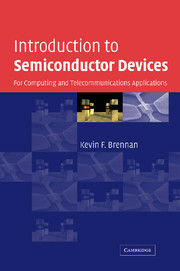Book contents
- Frontmatter
- Contents
- Preface
- List of physical constants
- List of materials parameters for important semiconductors, Si and GaAs
- 1 Semiconductor fundamentals
- 2 Carrier action
- 3 Junctions
- 4 Bipolar junction transistors
- 5 JFETs and MESFETs
- 6 Metal–insulator–semiconductor structures and MOSFETS
- 7 Short-channel effects and challenges to CMOS
- 8 Beyond CMOS
- 9 Telecommunications systems–an overview
- 10 Optoelectronic devices – emitters, light amplifiers, and detectors
- 11 Transistors for high frequency, high power amplifiers for wireless systems
- References
- Index
4 - Bipolar junction transistors
Published online by Cambridge University Press: 05 June 2012
- Frontmatter
- Contents
- Preface
- List of physical constants
- List of materials parameters for important semiconductors, Si and GaAs
- 1 Semiconductor fundamentals
- 2 Carrier action
- 3 Junctions
- 4 Bipolar junction transistors
- 5 JFETs and MESFETs
- 6 Metal–insulator–semiconductor structures and MOSFETS
- 7 Short-channel effects and challenges to CMOS
- 8 Beyond CMOS
- 9 Telecommunications systems–an overview
- 10 Optoelectronic devices – emitters, light amplifiers, and detectors
- 11 Transistors for high frequency, high power amplifiers for wireless systems
- References
- Index
Summary
A bipolar junction transistor (BJT) consists of two p–n junctions with three terminals. The device comprises three different doped layers. These are alternating p, n, and p layers or n, p, and n layers. The first type of device is called a pnp BJT, while the second device is an npn BJT. The first layer is called the emitter. The second layer is called the base and the third layer is called the collector. Thus for a pnp BJT, the emitter and collector regions are p-type while the base is n-type. The two p–n junctions are then formed between the emitter and base and collector and base. The vast majority of BJT applications are in analog electronics, but BJTs can also be employed in digital circuitry.
BJT operation
A BJT can be used in several circuit configurations. In most applications the input signal is across two of the BJT leads while the output signal is extracted from a second pair of leads. Since there are only three leads for a BJT, one of the leads must be common to both the input and the output circuitry. Hence we call the different circuit configurations common emitter, common base, and common collector to identify the lead common to both the input and the output. These configurations are shown in Fig. 4.1. The most commonly employed configuration is the common emitter configuration.
A BJT can be biased into one of four possible modes. These are saturation, active, inverted, and cutoff.
Information
- Type
- Chapter
- Information
- Introduction to Semiconductor DevicesFor Computing and Telecommunications Applications, pp. 78 - 100Publisher: Cambridge University PressPrint publication year: 2005
